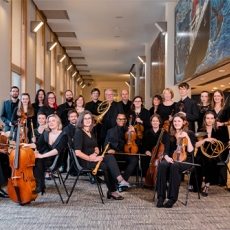Dunedin Consort - J.S. Bach: Christmas Oratorio - Early Music Review
Performance ![]()
Recorded sound ![]()
Booklet note ![]()
Overall presentation ![]()
John Butt's Christmas Oratorio with the Dunedins is splendid, from the crisp and perfectly tuned opening timpani strokes onward, and I hope it will sweep all before it as this Christmas' ‘must-have' for all EMR readers.
There are, of course, some things that I would do differently, but the vigour and balance of the ensemble, the quality of the instrumental playing, the perfectly judged tempi, the intelligent singers' splendid phrasing and breath control and the overall sense of line from all the performers combine to make this the best complete Christmas Oratorio I know.
In the glossy booklet, and more fully in the digital material on the Linn website, John Butt explains why he uses two four-voice cori: in a matter of twelve days, there is too much to prepare and sing for one group. Bach had a minimum of two four-voice groups at his disposal in Leipzig, so this performance uses the two, and for much of the chorus-work of Cantatas 1, 3 and 6 (those with a fuller scoring, including trumpets and drums), he adds four ripienists to the concerted sections at times. (For how this is done, listen to the opening chorus of Cantata 3, Herrscher des Himmels.) This is not the only or ‘right' solution, as he is at pains to point out, but it is one way of sharing the load - and this would also be true of a modern concert performance when all six cantatas are performed in the same programme.
So what is novel in the Dunedin's recording is the make-up of the cori? The first group has many of Butt's regulars; Nicholas Mulroy and Matthew Brook are joined by the incomparable Clare Wilkinson, with Mary Bevan as the soprano. Bevan's duets with Brook are fine, but her style is more operatic than I would like, and even in the chorus work she still uses a good deal of vibrato and pushes on some of the notes. So the change when we move to Cantata 2 and the second quartet takes over is all the more striking. Just listen to the first chorale Brich an, o schönes Morgenlicht and notice the clarity of Joanne Lunn's very first line, a purity of sound that is equally good in her arias and the important ariosos in Cantata 4: I doubt if you will ever hear a better Flößt, mein Heiland in that cantata. This is a world-class singer at her best.
She is partnered in that coro by Thomas Hobbs - just the right weight and agility for Frohe Hirten with Katy Bircher's lovely flute obbligato in Cantata 2 and the busy aria with the two violins Ich will nur in Cantata 4. Again, I cannot imagine a better performance, and this leaves Nicholas Mulroy to sing the more heroic numbers in 1, 3 and 6, like Nun mögt ihr stolzen Feinde schrecken in 6, that he does so well. I am less convinced by the mezzo Ciara Hendrick: I kept longing for the clarity and phrasing that Clare Wilkinson would bring to that ensemble - she would be such a good partner to Lunn and Hobbs, and I missed her in 5.i, Ehre sei dir, Gott which goes at a cracking pace, but perfectly in control with the tricky violin figuration in bar 57 perfectly in tune; but at least we have her in the wonderful performance of 3.viii Schließe, mein Herze, where she and Cecilia Bernardini cradle each others lines to perfection.
The bass Konstantin Wolff is new to me, and he does not quite have the warmth needed for the ariosos in 4.iii and 4.v, nor the clarity for the bass line in 2.xii. The bass line is always tricky in Bach: a voice that has enough depth and edge to make a good foundation for a coro and to sing the more rumbustious arias like 1.viii Großer Herr cannot always manage the more lyrical numbers like 5.v Erleucht auch meine finstre Sinnen convincingly. Matthew Brook can do both, and characterfully, but I am less convinced by Konstantin Wolff.
The singers in 1, 3 and 6, even without the ripienists, make a more robust sound, though Clare Wilkinson is always in danger of being shouted down by the higher pitched singers. Butt's attention to and feeling for instrumental balance and blend is so very fine, I just wish he would call his talented singers to order more. When I watched the Windsbacher Knabenchor rehearsing this summer, I was struck by the amount of time they spent in vocal training together each day, matching tone and balance between the parts. While the two types of cori are not directly parallel, they are both seeking clarity in Bach's complex music, whether in chorales or polyphonic and fugal writing. And there are some wobbles even in Joanne Lunn's otherwise impeccable line in 2.xii: are they ornaments - on weak notes? When John Butt directs Monteverdi madrigals, better control seems to be in place: what is different here?
There are one or two other minor queries. First about the bass line: does the absence of an independent fagotto part (only in Cantata 1 does a part survive) mean that a fagotto should not play in the remaining cantatas? While I realize that John Butt is following the surviving parts strictly, I missed it for example in 2.ix at the bottom of the oboe band, though I realize that Bach frequently seems not to have followed our convention of using the bassoon as the standard bass line for oboes. And should the violone play everywhere if it is always at 16' pitch? I found it more intrusive than I was expecting in some arias like 2.vi Frohe Hirten. Second, as always with John Butt, we have splendid information about the edition, the pitch and temperament, but nothing about the instruments. And third, why is so much booklet space given to the singers and all the operatic roles they have taken when no details at all are given about the splendid players, who are equal partners in this fine music-making, and a photograph on pp 54/55 which does not relate to this recording, showing a recorder and many more string players than took part.
None of this detracts essentially from what is a first rate and wonderfully musical performance. They deserve every plaudit they will get.


